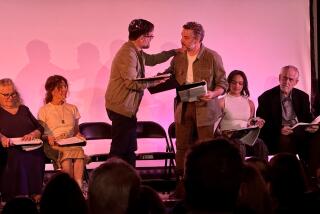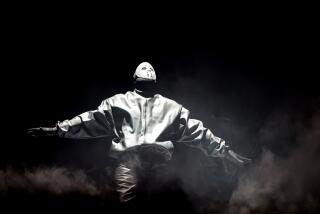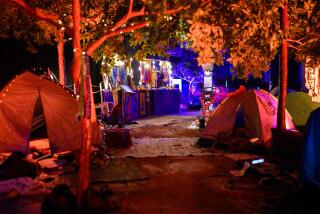In the Aftermath, Fretful Times for China’s Arts Scene
BEIJING — The city is eerily quiet these hot summer evenings. With martial law still in effect, young soldiers stand at attention, guns in hand, throughout the city. On the few occasions they speak, it is to tell someone to move along.
Television runs hours and hours of Communist Party meetings--rows of men in blue Mao suits, sitting with their lidded cups of tea, making long speeches in praise of their leaders. TV movies are resurrected films of the ‘50s and ‘60s, when artistic expression was held firmly in accord with the party line.
Since June 4, the night the army opened fire in Tian An Men Square, Beijing’s arts scene has changed vastly. What is most evident is what can no longer be seen. Some Chinese performers who made public statements supporting the demonstrators, or who gave benefit performances to raise money for the students, are nowhere to be found. Others are flatly denying that they were even involved.
Indeed, the arts and culture of China may be facing the worst repression since the “cultural revolution” of 1966-76. News announcements from the government to film makers, television producers, journalists, artists and writers order them to get their works in line with Communist Party goals.
Artists and writers are being told that their function is “to develop socialist art and literature, to adhere to the party’s four cardinal principles (socialism, the leadership of the party, Marxism and the democratic dictatorship) and to oppose bourgeois liberalization.”
And the government has declared that martial law will continue to be enforced in Beijing until the leaders are satisfied that order has been completely restored.
It would be tantamount to an act of suicide to sing a controversial song or publish a critical essay these days. Acrobats, traditional art, Peking opera and pro-government documentaries are the order of the day.
Peking Opera performances reopened two weeks ago in a 1,300-seat theater and fewer than 30 tickets were sold.
“We tried very hard to reopen, but people are still avoiding to go out in the evenings,” said Zhang Yu, deputy director of the Jixiang Theater. “We canceled the plays not only because of financial losses, but for the sake of our artists. No one has the heart to play to an empty hall.”
The Peking Opera reopened again this weekend. It focused on the noncontroversial with “Havoc in Heaven” and three other traditional operas Saturday and four episodes of “The Monkey King Story,” an ancient and beloved Peking Opera staple, on Sunday. Peking Opera acrobats are scheduled to appear today. But with tourism down 82% from last summer, audiences are expected to be small.
Films are drawing more crowds than Peking Opera, although there are no theaters showing the controversial films by the young “Fifth Generation” film makers who have been winning international awards in recent years.
The main summer film is “The Baise Uprising,” a period piece about Deng Xiaoping when, at age 25, he led a 1929 victory over the Nationalists. When it opened last week, it was command viewing for work units who filled two theaters. The Communist Party has given it extensive publicity, linking it to the 60th anniversary of the Baise action and the 40th year of Communist rule in China.
Newly released but drawing fair-sized crowds in the afternoons and early evenings (nights find guards patrolling the streets and few other people about) is another Communist-backed film, “Kunlun Garrison,” featuring the heroic Mao Tse-tung and his comrades, Chou En-lai and Ren Bishi, fighting against the Kuomintang government in 1947, an important historical event in the rise of Communist China.
The film’s timing was serendipitous. It was shot before the demonstrations but it’s just what the Communists would have ordered: patriotic theme, gripping drama, the glories of a Communist victory over the government.
“From an artistic view, the movie is very good, although I think people resent that it’s being used for propaganda purposes,” said a film critic who spoke on condition of anonymity.
One scene showing student demonstrators protesting against the government was cut from three minutes to about 10 seconds. It’s essential to the plot so it’s included, but very briefly. Still, when the big screen filled with demonstrators from the 1940s marching along a Shanghai street chanting for an end to corruption, the audience in the dark theater burst into applause. It was over as quickly as it began, but the heat of the moment left an indelible mark.
There are no rock concerts on Beijing’s calendar, although one large but private rock performance drew hundreds of youths to a dance the weekend before last. They said it was the first time since before the turmoil that they’d heard of any large gatherings of this sort.
Beijing’s most famous rock star, Cui Jian, is performing on weekends with his band at the Great Wall Sheraton Hotel, attracting some of the few remaining resident foreigners and business travelers. It’s a far cry from his wildly popular sell-out rock concerts of months past that attracted hundreds of Chinese fans.
The Beijing Concert Hall, never a bastion of controversy, plans a concert of Erhu, a Chinese traditional musical instrument, for today. The Lao She Teahouse, which before the massacres six weeks ago would be filled with foreign tourists nightly, now is filled with Chinese people who are having the time of their lives.
And performing for them there are such Chinese superstars as magician Pan Changlin and comedian Guan Xuzeng, along with several Peking opera stars who had been idle in recent weeks.
Exhibitions at the newly reopened China Art Gallery in the heart of the city are dishearteningly innocuous. The reopening featured four artists who are showing only traditional Chinese paintings, two rural folk artists from other provinces and an artist from Ecuador.
The new exhibit at the gallery is of stone sculptures by Wang Zhiguo, an artist from Shandong Province who carves stones collected from the ocean floor. Also on display are calligraphy, portrait photography and folk art from Huazhou. Gone are the controversial nudes, the political cartoons and the Western-influenced artists who had statements to make.
“Three months ago I made regular visits to the gallery,” an art critic said. “The exhibits were more and more liberal and controversial. In the last four years the gallery had been moving from the very traditional into the modern and exciting things that have been happening in Chinese art. Finally, there was a prestigious place for bold, experimental artists to exhibit, artists from the Central Art Academy (of Beijing), the Shanghai Art Academy and the Zhegiang Art Academy, mainly. But not now. There’s nothing exciting going on there now, and I don’t expect to see anything really interesting there for some time.”
News reports said that members of “Beijing’s literary and art circles voiced their opposition to bourgeois liberalization at a discussion sponsored by the Propaganda Department of the Chinese Communist Party Central Committee.”
The article went on to say that “an extremely small number of people who advocate bourgeois liberalization have created much confusion among art and literary workers by spreading fallacies.”
The government is urging tourists to come back to China, saying that for them conditions are just fine. Art has been stifled, along with all other expressions promoting freedom and individuality, but in spite of deep layers of grief and anger, life goes on.
More to Read
Sign up for Essential California
The most important California stories and recommendations in your inbox every morning.
You may occasionally receive promotional content from the Los Angeles Times.










